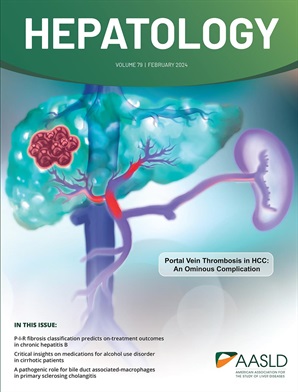Distinctive hemodynamic phenotype in Fontan-type circulation patients with distal esophageal varices.
IF 15.8
1区 医学
Q1 GASTROENTEROLOGY & HEPATOLOGY
引用次数: 0
Abstract
BACKGROUND AIMS Esophageal varices (EV) are common in adults with Fontan-type circulation and may arise via distinct hemodynamic mechanisms depending on their anatomic location. We aimed to determine the prevalence, anatomical distribution and hemodynamic correlates of EV in this population. APPROACH RESULTS In this prospective cohort study, 114 consecutive adults with Fontan-type circulation underwent combined hepatic and cardiac catheterization, esophagogastroduodenoscopy, and liver biopsy. Patients were classified by endoscopic findings into those with and without EV, and the EV cohort was further stratified by location (proximal or distal). EV were present in 36.8% (95% CI, 27.9-45.8%), including 28.9% with distal EV and 17.5% with proximal EV. Over a median follow-up of 48.9 months (IQR, 27.1-85.5), only one variceal bleeding event occurred. Patients with distal EV exhibited the highest cardiac index and pulmonary, systemic and hepatic venous pressures, as well as the lowest systemic vascular resistance (all p<0.01). Severe hepatic fibrosis was more frequent in this group (87.9%) than in patients without EV (33.8%) or those with proximal EV (25.0%). Non-invasive fibrosis markers (liver stiffness, FIB-4, Forns index, FonLiver risk score) were significantly elevated in patients with distal EV (all p<0.05), despite similar biochemical profiles. CONCLUSION Distal EV are frequent and characterize a distinct hemodynamic phenotype, featuring elevated Fontan pathway pressures, severe hepatic fibrosis, portal hypertension, and a hyperdynamic circulatory state.fontan型循环伴食管远端静脉曲张患者的独特血流动力学表型。
背景:食管静脉曲张(EV)在fontan型循环的成人中很常见,根据其解剖位置的不同,可能通过不同的血流动力学机制发生。我们的目的是确定EV在这一人群中的患病率、解剖分布和血流动力学相关因素。方法结果:在这项前瞻性队列研究中,114例连续的fontan型循环患者接受了肝和心导管联合穿刺、食管胃十二指肠镜检查和肝活检。根据内窥镜检查结果将患者分为有和没有EV,并根据位置(近端或远端)进一步分层EV队列。36.8% (95% CI, 27.9-45.8%)存在EV,其中28.9%为远端EV, 17.5%为近端EV。中位随访48.9个月(IQR, 27.1-85.5),仅发生一例静脉曲张出血事件。远端EV患者心脏指数最高,肺、全身和肝静脉压最高,全身血管阻力最低(p<0.01)。严重肝纤维化在本组发生率(87.9%)高于无肝纤维化组(33.8%)和近端肝纤维化组(25.0%)。非侵袭性纤维化指标(肝硬度、FIB-4、Forns指数、FonLiver风险评分)在远端EV患者中显著升高(均p<0.05),尽管生化特征相似。结论远端EV发生频率高,具有明显的血流动力学表型,表现为Fontan通路压力升高、严重肝纤维化、门脉高压和高动力循环状态。
本文章由计算机程序翻译,如有差异,请以英文原文为准。
求助全文
约1分钟内获得全文
求助全文
来源期刊

Hepatology
医学-胃肠肝病学
CiteScore
27.50
自引率
3.70%
发文量
609
审稿时长
1 months
期刊介绍:
HEPATOLOGY is recognized as the leading publication in the field of liver disease. It features original, peer-reviewed articles covering various aspects of liver structure, function, and disease. The journal's distinguished Editorial Board carefully selects the best articles each month, focusing on topics including immunology, chronic hepatitis, viral hepatitis, cirrhosis, genetic and metabolic liver diseases, liver cancer, and drug metabolism.
 求助内容:
求助内容: 应助结果提醒方式:
应助结果提醒方式:


